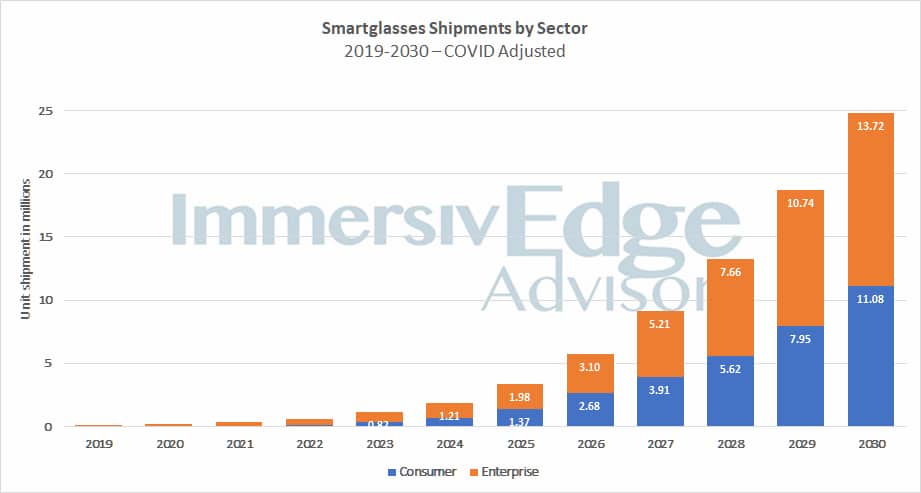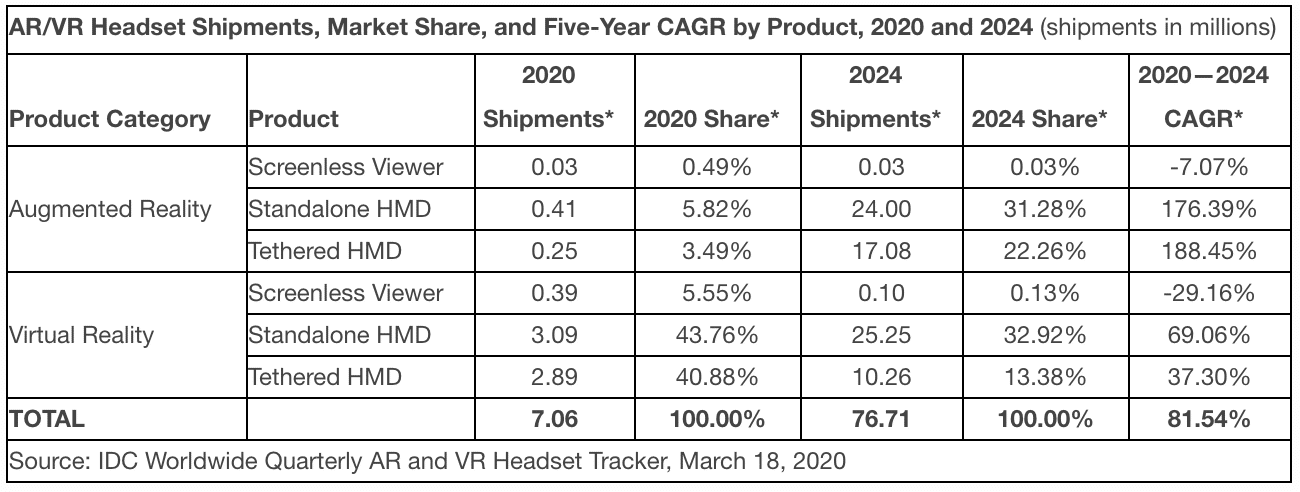
Data Point of the Week is AR Insider’s dive into the latest spatial computing figures. It includes data points, along with narrative insights and takeaways. For an indexed collection of data and reports, subscribe to ARtillery Pro.
There have been lots of inflated expectations about AR’s near-term impact as the “next computing platform.” That hasn’t panned out in terms of consumer traction, but it doesn’t mean AR isn’t legit. As Bill Gates said, we tend to overestimate the next one year but underestimate the next 10.
In that spirit, Immersive Edge Advisors released projections with a longer time horizon than the typical five-year window published by analysts (including our research arm, ARtillery Intelligence*). Its latest report looks to define what we call AR’s “exploring-20’s,” projecting out to 2030.

$34 Billion Market
Specifically, Ben Delaney and co. project a $5 billion smartglasses market by 2025, and $34 billion by 2030. This counts consumer and enterprise hardware as well as software and services. The firm believes smartglasses will largely replace smartphones and smartwatches by 2030.
Breaking that down, Immersive Edge projects annual smartphone sales of 25 million units by 2030. Consumer glasses will outpace enterprise, just as we’ve speculated. As a qualifier, this is different than an installed base figure that measures cumulative in-market hardware.
Qualitatively speaking, there will be several purpose-built formats, but we could see designer-eyewear quality smart glasses by the mid-2020s. To achieve such design targets, glasses will offload compute and graphics processing to edge computing and tethered smartphones.
The wild card for consumer AR of course is Apple, as its entrance could inflect the market through its signature halo effect. Beyond Apple, more reliable accelerants lie in enterprise AR such as training, logistics, emergency response, military, maintenance, and healthcare.

Vantage Points
Panning back, one thing that strikes us is Immersive Edge’s measured approach, which largely undercuts common aggressive figures of IDC and others. For that statement and all that follow, please recognize our bias and affiliation* with fellow research firm ARtillery Intelligence.
Wrapping some numbers around that comparison, the aforementioned 25 million smartglasses by 2030 compares to IDC’s projection of 41.1 million units by 2024 (see below). That’s apples to oranges in terms of timeframes, but can be normalized and compared in growth rates.
There, IDC is clearly more aggressive. Being aggressive isn’t always bad, but 41 million headsets by 2024 compare to last year’s AR headset sales of 260,000 according to ARtillery’s calculations. It’s also a large gap to cover in four years from IDC’s own 2020 estimate of 800,000 units.
Speaking of ARtillery Intelligence, we’ll bring its figures into this exercise as a third comparative source. It projects 2.89 million AR glasses by 2023. That puts it more in line with Immersive Edge, in terms of the market pacing that would lead us to roughly 25 million annual units by 2030.


Wearables Suite?
The one thing we’d challenge slightly in Immersive Edge’s projections is the replacement effect AR glasses could have on smartphones and smartwatches. We believe AR glasses will be part of a constellation of wearables that augments our senses holistically, and from many angles.
Not only is that fitting to our sensory makeup and varied needs (components to pick and choose in different contexts), but the mighty Apple is incentivized to throw it’s weight in that direction, as we’ve speculated. Then again, we concede that anything can happen in the next decade.
Meanwhile, Immersive Edge has published an addendum to the report that adjusts figures for supply chain constraints and other impacts of Covid-19 (reflected in the charts above). Delaney tells us this alters the next few quarters, then recovers to the same long term outlook.
* AR Insider is owned by ARtillery Intelligence, meaning that potential bias in any analysis of third-party market sizing should be considered. See disclosure and ethics policy here.
For deeper XR data and intelligence, join ARtillery PRO and subscribe to the free AR Insider Weekly newsletter.
Disclosure: AR Insider has no financial stake in the companies mentioned in this post, nor received payment for its production. Disclosure and ethics policy can be seen here.
Header Image Credit: Microsoft
